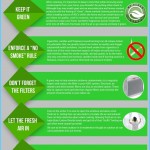HIDDEN DANGERS While the odour of VOCs can give you a clue to their presence, other sources of indoor pollution are less obvious. A mixture of solid particles and liquid droplets, particulate matter (PM) can be as small as 2.5 micrometres in diameter; so tiny, they can penetrate deep into your lungs and bloodstream, causing havoc.
Short-term exposure can lead to eye, nose and throat irritation, coughing, acute bronchitis or asthma attacks, while longer exposure has been associated with reduced lung function, chronic bronchitis, heart attack and even premature death.
10 WAYS TO IMPROVE INDOOR AIR QUALITY Photo Gallery
Produced indoors by cooking techniques such as stir-frying (which produces lots of hot oil particles) and faulty or flueless gas appliances, PMs also come from pet dander, mould, bacteria and dust mites. To reduce their presence, service your gas appliances regularly, use a damp cloth to dust the furniture, try to minimise moisture levels indoors and make sure your home is well ventilated.
An indoor air pollution monitor (see panel below) will indicate when you need to open windows, but check the outdoor levels first (simply key in your postcode at uk-air. defra.gov.uk) or you may just be inviting more bad air in. For a natural solution, Puressentiel Purifying Air Spray (£19.99 for 200ml; boots.com) contains 41 essential oils and has been shown to kill an average 98.5 per cent of bacteria and dust mites. You might also want to consider investing in an air purifier.
10 WAYS TO IMPROVE INDOOR AIR QUALITY
1. Use the extractor fan when cooking and change the filter regularly
2 USE SOLID WOOD FURNITURE WHERE POSSIBLE
3. DRY CLOTHES OUTSIDE WHEN YOU CAN
4. CONSIDER AN AIR PURIFIER
5 YOUR HOUSE REGULARLY
6. Opt for natural or organic toiletries and cleaning products
7. Minimise the use of non-organic scented candles AIR
9. COOK WITH ELECTRICITY RATHER THAN GAS
10. Dust your home two to three times a week 8. Change vacuum cleaner filters regularly






